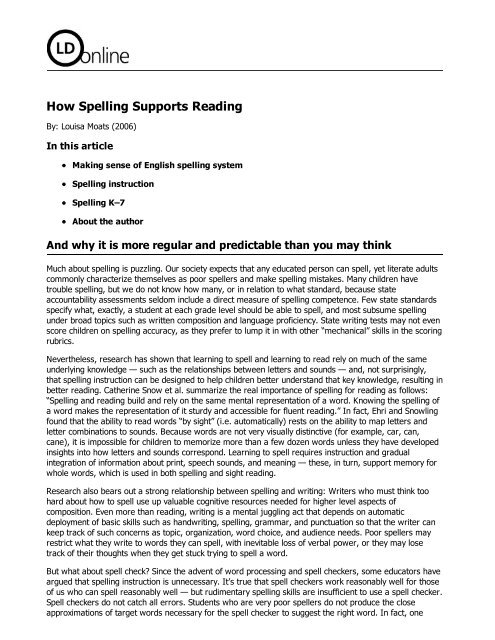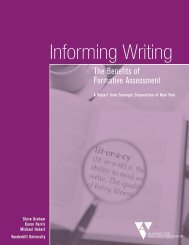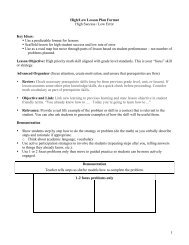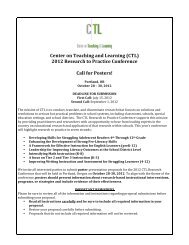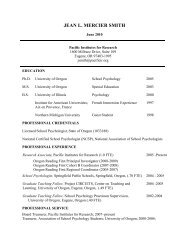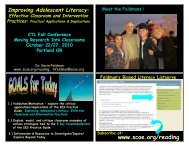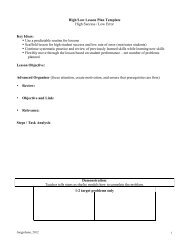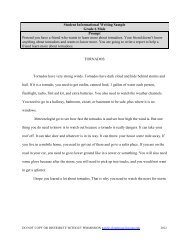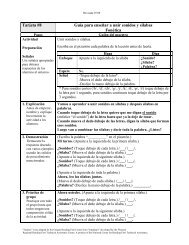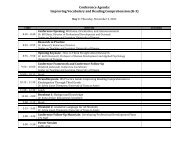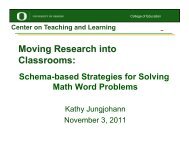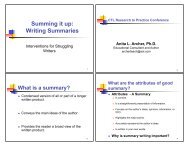How Spelling Supports Reading - Center on Teaching and Learning
How Spelling Supports Reading - Center on Teaching and Learning
How Spelling Supports Reading - Center on Teaching and Learning
Create successful ePaper yourself
Turn your PDF publications into a flip-book with our unique Google optimized e-Paper software.
<str<strong>on</strong>g>How</str<strong>on</strong>g> <str<strong>on</strong>g>Spelling</str<strong>on</strong>g> <str<strong>on</strong>g>Supports</str<strong>on</strong>g> <str<strong>on</strong>g>Reading</str<strong>on</strong>g>By: Louisa Moats (2006)In this articleMaking sense of English spelling system<str<strong>on</strong>g>Spelling</str<strong>on</strong>g> instructi<strong>on</strong><str<strong>on</strong>g>Spelling</str<strong>on</strong>g> K–7About the authorAnd why it is more regular <strong>and</strong> predictable than you may thinkMuch about spelling is puzzling. Our society expects that any educated pers<strong>on</strong> can spell, yet literate adultscomm<strong>on</strong>ly characterize themselves as poor spellers <strong>and</strong> make spelling mistakes. Many children havetrouble spelling, but we do not know how many, or in relati<strong>on</strong> to what st<strong>and</strong>ard, because stateaccountability assessments seldom include a direct measure of spelling competence. Few state st<strong>and</strong>ardsspecify what, exactly, a student at each grade level should be able to spell, <strong>and</strong> most subsume spellingunder broad topics such as written compositi<strong>on</strong> <strong>and</strong> language proficiency. State writing tests may not evenscore children <strong>on</strong> spelling accuracy, as they prefer to lump it in with other “mechanical” skills in the scoringrubrics.Nevertheless, research has shown that learning to spell <strong>and</strong> learning to read rely <strong>on</strong> much of the sameunderlying knowledge — such as the relati<strong>on</strong>ships between letters <strong>and</strong> sounds — <strong>and</strong>, not surprisingly,that spelling instructi<strong>on</strong> can be designed to help children better underst<strong>and</strong> that key knowledge, resulting inbetter reading. Catherine Snow et al. summarize the real importance of spelling for reading as follows:“<str<strong>on</strong>g>Spelling</str<strong>on</strong>g> <strong>and</strong> reading build <strong>and</strong> rely <strong>on</strong> the same mental representati<strong>on</strong> of a word. Knowing the spelling ofa word makes the representati<strong>on</strong> of it sturdy <strong>and</strong> accessible for fluent reading.” In fact, Ehri <strong>and</strong> Snowlingfound that the ability to read words “by sight” (i.e. automatically) rests <strong>on</strong> the ability to map letters <strong>and</strong>letter combinati<strong>on</strong>s to sounds. Because words are not very visually distinctive (for example, car, can,cane), it is impossible for children to memorize more than a few dozen words unless they have developedinsights into how letters <strong>and</strong> sounds corresp<strong>on</strong>d. <strong>Learning</strong> to spell requires instructi<strong>on</strong> <strong>and</strong> gradualintegrati<strong>on</strong> of informati<strong>on</strong> about print, speech sounds, <strong>and</strong> meaning — these, in turn, support memory forwhole words, which is used in both spelling <strong>and</strong> sight reading.Research also bears out a str<strong>on</strong>g relati<strong>on</strong>ship between spelling <strong>and</strong> writing: Writers who must think toohard about how to spell use up valuable cognitive resources needed for higher level aspects ofcompositi<strong>on</strong>. Even more than reading, writing is a mental juggling act that depends <strong>on</strong> automaticdeployment of basic skills such as h<strong>and</strong>writing, spelling, grammar, <strong>and</strong> punctuati<strong>on</strong> so that the writer cankeep track of such c<strong>on</strong>cerns as topic, organizati<strong>on</strong>, word choice, <strong>and</strong> audience needs. Poor spellers mayrestrict what they write to words they can spell, with inevitable loss of verbal power, or they may losetrack of their thoughts when they get stuck trying to spell a word.But what about spell check? Since the advent of word processing <strong>and</strong> spell checkers, some educators haveargued that spelling instructi<strong>on</strong> is unnecessary. It’s true that spell checkers work reas<strong>on</strong>ably well for thoseof us who can spell reas<strong>on</strong>ably well — but rudimentary spelling skills are insufficient to use a spell checker.Spell checkers do not catch all errors. Students who are very poor spellers do not produce the closeapproximati<strong>on</strong>s of target words necessary for the spell checker to suggest the right word. In fact, <strong>on</strong>e
study reported that spell checkers usually catch just 30 to 80 percent of misspellings overall (partlybecause they miss errors like here vs. hear), <strong>and</strong> that spell checkers identified the target word from themisspellings of students with learning disabilities <strong>on</strong>ly 53 percent of the time.Clearly, the research base for claiming that spelling is important for young children is solid: <strong>Learning</strong> tospell enhances children’s reading <strong>and</strong> writing. But what about middle-school students? Does c<strong>on</strong>tinuedspelling instructi<strong>on</strong> offer any added benefits? Here the research is sparse indeed. Yet, the nature of theEnglish language’s spelling/writing system provides reas<strong>on</strong> to believe that there would be significantbenefits to older students from allocating a small amount of time to c<strong>on</strong>tinued, appropriate spellinginstructi<strong>on</strong>. In additi<strong>on</strong> to c<strong>on</strong>tinuing to learn the rules of spelling, students can develop a deepunderst<strong>and</strong>ing of English by studying the meanings of roots, prefixes, <strong>and</strong> suffixes; families of relatedwords; the historical development of the English language; <strong>and</strong> words’ language of origin. It’s very likelythat this sort of word study (in additi<strong>on</strong> to being intrinsically interesting to many students) would supportvocabulary development <strong>and</strong> facilitate reading by enabling students to view any new word from the anglesof sound, meaning, language of origin, <strong>and</strong> syntax. As a result, students would be more likely to be able tofigure out the new word’s meaning as well as how to spell it <strong>and</strong> how to use it with precisi<strong>on</strong>.Those of us who can spell reas<strong>on</strong>ably well take for granted the role that spelling plays in daily life. Filingalphabetically; looking up words in a ph<strong>on</strong>e book, dicti<strong>on</strong>ary, or thesaurus; recognizing the right choicefrom the possibilities presented by a spell checker; writing notes that others can read—<strong>and</strong> even playingparlor games—are all dependent <strong>on</strong> spelling. In a literate society, c<strong>on</strong>venti<strong>on</strong>al spelling is expected <strong>and</strong>anything bey<strong>on</strong>d a few small errors is equated with ignorance <strong>and</strong> incompetence. In fact, the Nati<strong>on</strong>alCommissi<strong>on</strong> <strong>on</strong> Writing for America’s Families, Schools, <strong>and</strong> Colleges reported that 80 percent of the timean employment applicati<strong>on</strong> is doomed if it is poorly written or poorly spelled. Why does spelling appear <strong>on</strong>the <strong>on</strong>e h<strong>and</strong> to be simple, something any reas<strong>on</strong>ably intelligent pers<strong>on</strong> should be able to do, but <strong>on</strong> theother h<strong>and</strong>, cause so many students academic grief? <str<strong>on</strong>g>How</str<strong>on</strong>g> can spelling be taught so that it will supportreading instructi<strong>on</strong> as well as help students underst<strong>and</strong> how the spelling system works <strong>and</strong> see the ways inwhich spelling is predictable? This article attempts to answer both of these questi<strong>on</strong>s by first exploring thenature of the English language’s writing/spelling system <strong>and</strong>, sec<strong>on</strong>d, by outlining the key c<strong>on</strong>tent thatstudents should master in kindergarten through seventh grade.Back to topMaking sense of the English spelling system (it’s not as irregular as youthink)The spelling of words in English is more regular <strong>and</strong> pattern-based than comm<strong>on</strong>ly believed. According toHanna, Hanna, Hodges, <strong>and</strong> Rudorf (1966), half of all English words can be spelled accurately <strong>on</strong> the basisof sound-symbol corresp<strong>on</strong>dences al<strong>on</strong>e, meaning that the letters used to spell these words predictablyrepresent their sound patterns (e.g., back, clay, baby). These patterns, though, are somewhat complex<strong>and</strong> must be learned (e.g., when to use "ck" as in back <strong>and</strong> when to use "k" as in book). Another 34percent of English words would <strong>on</strong>ly have <strong>on</strong>e error if they were spelled <strong>on</strong> the basis of sound-symbolcorresp<strong>on</strong>dences al<strong>on</strong>e. (1) That means that the spelling of 84 percent of words is mostly predictable. Manymore words could be spelled correctly if other informati<strong>on</strong> was taken into account, such as word meaning<strong>and</strong> word origin. The authors estimated that <strong>on</strong>ly four percent of English words were truly irregular. (2)Thus, the spelling of almost any word can be explained if <strong>on</strong>e or more of the following five principles ofEnglish spelling is taken into account:Words’ language of origin <strong>and</strong> history of use can explain their spelling.Words’ meaning <strong>and</strong> part of speech can determine their spelling.Speech sounds are spelled with single letters <strong>and</strong>/or combinati<strong>on</strong>s of up to four letters.The spelling of a given sound can vary according to its positi<strong>on</strong> within a word.The spellings of some sounds are governed by established c<strong>on</strong>venti<strong>on</strong>s of letter sequences <strong>and</strong>
patterns.Each principle is explained in broad strokes <strong>and</strong> illustrated with <strong>on</strong>e or more examples over the nextseveral pages. Together, the first two principles explain why English words are so complex—<strong>and</strong> why thatcomplexity is well worth the frustrati<strong>on</strong> it causes for beginning spellers (<strong>and</strong> readers). The last threeprinciples reveal the order behind the seeming chaos; for the most part, these three result from wellmeaningattempts to bring regularity to the English language.As you read about these principles, keep in mind that this part of the article is designed to help teachersbetter underst<strong>and</strong> the nature <strong>and</strong> structure of the English spelling system. This is essential backgroundknowledge for teachers of reading, spelling, <strong>and</strong> writing. As Snow et al. explained, the rules for spellingare very complex, "so it is not surprising that many highly literate adults who use those rules correctly [<strong>and</strong>automatically] find it difficult to talk about them or answer questi<strong>on</strong>s about them. Teachers who have beentaught about ph<strong>on</strong>ics have typically received informati<strong>on</strong> about [spelling] as lists of rules about lettersequence c<strong>on</strong>straints. Such lists are unmotivated, unappealing, <strong>and</strong> difficult to learn. Lists without a logicalframework or set of principles must be learned by rote rather than reas<strong>on</strong>." By providing a logicalframework, these five principles transform spelling from an arbitrary list of rules about how letters can <strong>and</strong>cannot be combined into a structured system. Secti<strong>on</strong> two of this article offers a way of breaking thatsystem into key c<strong>on</strong>tent for instructi<strong>on</strong> in kindergarten through seventh grade.Words’ language of origin <strong>and</strong> history of use can explain their spellingOne of the main reas<strong>on</strong>s that English seems so irregular is that we have lots of different spellings for thesame sound. For example, the /k/ sound can be spelled with several different letters <strong>and</strong> lettercombinati<strong>on</strong>s, such as k (king), c (cat), ck (back), qu (queen), <strong>and</strong> ch (chorus). Why is this? ModernEnglish has been influenced by several core languages, primarily Anglo- Sax<strong>on</strong>, Norman French (a dialectof Old French used in medieval Norm<strong>and</strong>y), Latin, <strong>and</strong> Greek. Because each of these languagesc<strong>on</strong>tributed its own c<strong>on</strong>venti<strong>on</strong>s for spelling speech sounds, syllables, <strong>and</strong> meaningful units of speech, thespelling of a word is often related to, <strong>and</strong> even explained by, its history <strong>and</strong> language of origin.As illustrated in the timeline below, the story of the English language begins roughly 1,600 years ago withthe decline of the Roman Empire. At its height, the Roman Empire stretched from Britain to North Africa tothe Persian Gulf, but barbarian attackers forced the Empire to split apart <strong>and</strong> withdraw from its outposts.After the Romans left Britain in 450 A.D., Germanic tribes known as Jutes, Angles, <strong>and</strong> Sax<strong>on</strong>s invaded,pushing the Celtic inhabitants (who had lived under Roman rule for 400 years) to the west. As Celtic <strong>and</strong>Latin words, roots, <strong>and</strong> pr<strong>on</strong>unciati<strong>on</strong>s were absorbed into the invaders’ Low West German languages,Anglo-Sax<strong>on</strong> — or Old English — was born. The most comm<strong>on</strong>, frequent words of Modern English — likethose for animals, family members, numbers, comm<strong>on</strong> objects, emoti<strong>on</strong>s, <strong>and</strong> universal daily activities —are preserved from Anglo- Sax<strong>on</strong>. Some examples include goat, wife, mother, <strong>on</strong>e, house, love, cook, <strong>and</strong>walk. Of the 100 words used most often in English, all can be traced to Anglo-Sax<strong>on</strong> origins.Famously in 1066, Britain was invaded by William the C<strong>on</strong>queror from Norm<strong>and</strong>y. As a result, the NormanFrench language was imposed <strong>on</strong> the British natives for almost 400 years. Norman French <strong>and</strong> Old Englishwere gradually amalgamated, merging by the late 15th century into what is now known as Middle English.From Norman French we gained thous<strong>and</strong>s of terms for legal c<strong>on</strong>cepts, social <strong>and</strong> moral ideals, <strong>and</strong>artistic values (such as justice, peace, courageous, magnificent, <strong>and</strong> beauty). Though the Normans spokeNorman French, their cultured class wrote in both their native t<strong>on</strong>gue <strong>and</strong> Latin, languages that wereclosely related members of an Indo-European language family. Latin-based vocabulary became thelanguage of scholarship, commerce, <strong>and</strong> official discourse (such as solar, equine, residence, designate,<strong>and</strong> refer).During the Renaissance, which was a time of renewed interest in classical Roman <strong>and</strong> Greek culture <strong>and</strong>language, the growth of scientific disciplines created a need to name many discoveries. Scholars looked toGreek to coin new terms (such as atmosphere, gravity, <strong>and</strong> chr<strong>on</strong>ology). (3) At the same time, as printedmaterial became more comm<strong>on</strong> in the late 1500s, scholars trained in the classics brought even moreLatin-based words (such as malevolent, fortitude, maternal, stadium, <strong>and</strong> calculus) into English.What did all this merging, layering, <strong>and</strong> borrowing mean for English’s spelling system? The short answer isthat it became more complex: As explained below, the pr<strong>on</strong>unciati<strong>on</strong> of some of the oldest Anglo-Sax<strong>on</strong>
words diverged from their spelling, <strong>and</strong> both Norman French <strong>and</strong> Greek c<strong>on</strong>tributed some new spellings.Today, most of our regular sound-symbol corresp<strong>on</strong>dences come from the Anglo-Sax<strong>on</strong> layer of language(for example, almost all c<strong>on</strong>s<strong>on</strong>ant spellings). Ir<strong>on</strong>ically, most of our irregular spellings come from Anglo-Sax<strong>on</strong> as well. Because the spelling of a word usually changes much more slowly than its pr<strong>on</strong>unciati<strong>on</strong>,some of our oldest <strong>and</strong> most comm<strong>on</strong> words (such as said, does, friend, <strong>and</strong> enough) have retainedspellings that represent how they were pr<strong>on</strong>ounced eight or 10 centuries ago.Norman French c<strong>on</strong>tributed additi<strong>on</strong>al sound-symbol corresp<strong>on</strong>dences, such as the soft c for /s/ as injustice, soft g for /j/ as in courage, –ge for /zh/ as in garage, ou as in house (which was huse in OldEnglish), qu for /kw/ as in queen (which was cwene in Old English), –que for /k/ as in boutique, <strong>and</strong> –ettefor /?et/ as in baguette. No new sound-symbol corresp<strong>on</strong>dences were c<strong>on</strong>tributed by Latin <strong>and</strong> <strong>on</strong>ly a fewwere adopted from Greek spelling patterns: y for /i?/ as in gym, ph for /f/ as in philosophy, <strong>and</strong> ch for /k/as in chorus.During <strong>and</strong> after the Renaissance, however, English adopted words from many other languages—<strong>and</strong> theirspellings were adopted as well (e.g., barbecue, plaza, marijuana, <strong>and</strong> chocolate from Spanish; bayou,gauche, ballet, <strong>and</strong> levee from French; piano <strong>and</strong> cello from Italian; schmooze, schmaltz, <strong>and</strong> schlock fromYiddish). For the most part, these adopti<strong>on</strong>s added words to the English language, but unlike the earlierchanges in which spelling patterns were adopted (e.g., from cwene to queen), they did not affect alreadyestablished spelling patterns.The many layers of the English language do make it harder to learn to spell, but they also provide a richvocabulary: The English language has roughly double the number of words of seemingly comparablelanguages like German, Spanish, <strong>and</strong> French. As the lists below show, the layers of languages that mergedto form modern English have left us with many words to express our ideas.Anglo-Sax<strong>on</strong>NormanFrenchLatinWater Aquifer, aquarium Hydraulic,Hydrop<strong>on</strong>icGreekChange Transform MetamorphoseSad Morose Depressed Catat<strong>on</strong>icDead Deceased MoribundFortunately, the way English evolved, <strong>and</strong> particularly the way scholars drew from Latin roots <strong>and</strong> Greekbase words, resulted in many families of words with related meanings <strong>and</strong> similar spellings such thatwhole groups of words in Modern English can be learned together with relative ease. For example, asLatin was layered <strong>on</strong> top of Old English, Latin roots like dict (to speak) <strong>and</strong> med (to heal) resulted infamilies of words like these: dictum, dicti<strong>on</strong>ary, edict, indict; medical, medicine, remedy, remedial, etc. Ifyou are reading carefully you may be about to protest: These families of words have related meanings <strong>and</strong>similar spellings, but sometimes their pr<strong>on</strong>unciati<strong>on</strong>s are different. This brings us to the next principle.Words’ meaning <strong>and</strong> part of speech can determine their spellingEnglish words are spelled according to both their sounds (ph<strong>on</strong>emes, such as /b/) <strong>and</strong> their meaningfulparts (morphemes, such as the root dict). (4) In c<strong>on</strong>trast, languages like Spanish <strong>and</strong> Finnish, for example,use single, c<strong>on</strong>sistent letters <strong>and</strong> letter combinati<strong>on</strong>s for sounds; they pretty much stick to the job ofrepresenting ph<strong>on</strong>ology. Once you know the sound-letter corresp<strong>on</strong>dences, you can read <strong>and</strong> write inSpanish or Finnish. That may sound great to a struggling speller, but it comes at a cost: If you encounter anew word, its spelling doesn’t give you specific clues as to its meaning. In English, by c<strong>on</strong>trast, if you knowwhat to look for, you can find clues about an unknown word’s meaning. The words credible, credit,incredulous, <strong>and</strong> incredulity offer an example—all four share a Latin morpheme cred, a root meaning "tobelieve" that is preserved in spelling. And the last two also share the morpheme in, meaning not. Thespoken sounds of the words, however, differ c<strong>on</strong>siderably. A purely ph<strong>on</strong>etic, sound-by-sound spelling of
incredulous might be increjulous, but then the meaningful relati<strong>on</strong>ship between credible <strong>and</strong> incredulouswould be obscured. With written English, readers who know the Latin morphemes in <strong>and</strong> cred may accessword meaning directly. Meaning trumps pr<strong>on</strong>unciati<strong>on</strong> in the spelling of hundreds of English words. Hereare some additi<strong>on</strong>al examples: anxious, anxiety; define, definiti<strong>on</strong>; heal, health; wild, wilderness; <strong>and</strong> rite,ritual. The spelling of the morphemes is c<strong>on</strong>stant, but the pr<strong>on</strong>unciati<strong>on</strong> of the morphemes varies.We’ve dealt with the two big sources of complexity in English spelling: the layering of various languages asEnglish evolved <strong>and</strong> the emphasis <strong>on</strong> meaning instead of sounds. Now it’s time to run through the threeprinciples that make English spelling more predictable than you may think it is. These principles provide aframework for underst<strong>and</strong>ing those seemingly endless lists of rules that have given English spelling its badreputati<strong>on</strong>. We’ll start with the most straightforward principle <strong>and</strong> then build up to some odd — but regular— spellings, such as beginning <strong>and</strong> ending /j/ sounds in judge.Speech sounds are spelled with single letters <strong>and</strong>/or combinati<strong>on</strong>s of up to fourlettersThese sound-symbol relati<strong>on</strong>ships are known to linguists as ph<strong>on</strong>eme-grapheme corresp<strong>on</strong>dences. Aph<strong>on</strong>eme is the smallest speech sound that distinguishes words. The words beet, bit, bate, bet, bat, bite,but, bought, boat, boot, <strong>and</strong> bout are all distinguished from <strong>on</strong>e another by <strong>on</strong>e ph<strong>on</strong>eme — the vowelsound. A grapheme is a letter or letter combinati<strong>on</strong> that spells a ph<strong>on</strong>eme. Graphemes may be composedof <strong>on</strong>e to four letters, as in the following spellings for the /!a/ ph<strong>on</strong>eme: cradle, maybe, feign, <strong>and</strong> weigh.Although many ph<strong>on</strong>ics programs <strong>and</strong> assessments speak of “letter-sound” corresp<strong>on</strong>dences, the mappingsystem between sounds <strong>and</strong> symbols in English is more accurately c<strong>on</strong>ceptualized the other way around —as a map between ph<strong>on</strong>emes (sounds) <strong>and</strong> graphemes (the letters that spell those sounds). 5 In English,we have just 26 letters to work with — but we have about 40 ph<strong>on</strong>emes (sounds) <strong>and</strong> more than 250graphemes (ways to spell those sounds). The lists below provide some examples of the variety ofgraphemes that can be used to spell a single sound.Examples of GraphemesSpeechSoundExamples/m/ mitt, comb, hymn m, mb, mn/t/ tickle, mitt, sipped t, tt, ed/n/ nice, knight, gnat n, kn, gnGraphemes/aw/ saw, pause, call, bought aw, au, a, ough/u!/moo, tube, blue, chew, suit,soupoo, u_e, ue, ew, ui, ouThe idea of learning 250 graphemes may seem overwhelming at first, but spreading instructi<strong>on</strong> acrossseveral grades makes the task manageable for teachers <strong>and</strong> students. Most can be learned through directinstructi<strong>on</strong> <strong>and</strong> practice; some are learned more opportunistically, such as the various spellings for thevowel sound /u!/: ue, ui, ew, u, oo.Since the speech sounds in English can be spelled so many ways, how do we know when to use aparticular spelling? For those of us who cannot just “absorb” the right spelling as we mainly we need topractice recognizing <strong>and</strong> writing groups of words that share a given pattern. “Rules” are often predictableletter sequences that can be learned with a combinati<strong>on</strong> of pattern study <strong>and</strong> memorizati<strong>on</strong>. The next twoprinciples provide a framework that makes the patterns a little easier to learn.The spelling of a given sound can vary according to its positi<strong>on</strong> within a wordMaking sense of when to use which grapheme relies in part <strong>on</strong> the positi<strong>on</strong> of the sound in the word.
Scribes <strong>and</strong> dicti<strong>on</strong>ary writers invented some of these c<strong>on</strong>venti<strong>on</strong>s as our language absorbed new letters,sounds, <strong>and</strong> words from other languages. As an example, let’s focus <strong>on</strong> the three graphemes mostcomm<strong>on</strong>ly used to spell the ph<strong>on</strong>eme /k/: c (cast), k (kitty), <strong>and</strong> –ck (rock). (6) The letter c represents /k/most of the time: It is used in c<strong>on</strong>s<strong>on</strong>ant blends (as in clam, craft, <strong>and</strong> scroll) <strong>and</strong> is usually used beforethe vowel letters a, o, <strong>and</strong> u (as in catch, corncob, <strong>and</strong> cup). The letter k can represent /k/ before anyvowel, but it is almost always used before e, i, <strong>and</strong> y (as in ketchup, kid, <strong>and</strong> kyack); in these cases, theletter k is taking over for c because when c is followed by e, i, or y, it has its soft sound /s/ (as in cent,city, <strong>and</strong> cycle). The letters ck represent /k/ after a stressed short vowel (as in nickel) <strong>and</strong> at the end of<strong>on</strong>e-syllable words (as in back, rock, neck, <strong>and</strong> stuck).Not all c<strong>on</strong>s<strong>on</strong>ant or vowel spellings are that complex, but the choice of grapheme for a given speechsound is often determined by the speech sound that precedes or follows it. Here’s a less complicatedexample: When the sounds /f/, /l/, or /s/ directly follow a short vowel in <strong>on</strong>e-syllable words, a doubled f, l,or s is used to spell the sound (as in staff, will, <strong>and</strong> grass). Even vowel spellings, which can seem terriblycomplicated because they tend to have many graphemes for their short <strong>and</strong> l<strong>on</strong>g sounds, often becomemore predictable when the positi<strong>on</strong> of the vowel sound is c<strong>on</strong>sidered. For example, /ou/ can be spelledwith ou or ow — it’s just a matter of where the /ou/ sound appears. If it is at the beginning of a word, useou (as in out). If it is in the middle of a word or syllable, ou is usually correct (as in mouse <strong>and</strong> house) —except when /ou/ is followed by <strong>on</strong>ly a single n or l (as in brown <strong>and</strong> howl). Lastly, if the /ou/ sound is atthe end of the word or syllable, use ow (as in cow).The spellings of some sounds are governed by established c<strong>on</strong>venti<strong>on</strong>s of lettersequences <strong>and</strong> patternsWhen dicti<strong>on</strong>aries were first written <strong>and</strong> disseminated, rules for spelling had to be st<strong>and</strong>ardized. Scholarslike Samuel Johns<strong>on</strong> <strong>and</strong> Noah Webster worked to accommodate the norms of the day <strong>and</strong> give thelanguage more regularity.To illustrate this principle, we’ll examine the spellings for /v/ <strong>and</strong> /j/. It was not until the 1800s that theletters j <strong>and</strong> v were fully welcomed into the English alphabet.By then, scribes <strong>and</strong> writers of dicti<strong>on</strong>aries had determined that English words would not end with thoseletters because they were easy to visually c<strong>on</strong>fuse with i <strong>and</strong> u, respectively, the letters from which eachwas derived. Though it seems odd to us today, that is why the spelling –ve is always used when theph<strong>on</strong>eme /v/ ends an English word; the combinati<strong>on</strong> prevents a word from ending in plain v. Thus, wordswith short vowels ending in /v/ (have, give, glove) are "regular" from the st<strong>and</strong>point of spellingc<strong>on</strong>venti<strong>on</strong>s. Likewise, because j is not an opti<strong>on</strong> at the ends of words, the speech sound /j/ may bespelled with either –ge or –dge. English uses –dge right after an accented short vowel. Why? Because if itwere not for the extra c<strong>on</strong>s<strong>on</strong>ant protecti<strong>on</strong> of d, the letter e could reach back over the single c<strong>on</strong>s<strong>on</strong>ant g<strong>and</strong> make the vowel say its l<strong>on</strong>g vowel sound (badge, nudge vs. wage, huge).Here’s another example of a spelling c<strong>on</strong>venti<strong>on</strong>: The letter u is a marker for the hard /g/ sound in wordslike guest <strong>and</strong> guide. To see why it is necessary, you’ll need to know <strong>on</strong>e more example of the previousprinciple (that the spelling of a sound can be affected by its positi<strong>on</strong> in a word). Like the letter c, when g isfollowed by e, i, or y, it has its soft sound (/j/ as in gem, gist, <strong>and</strong> gym). So, in the case of guest <strong>and</strong>guide, the letter u intervenes between the g <strong>and</strong> the e or i, requiring the g to have its hard /g/ sound.C<strong>on</strong>venti<strong>on</strong>s like these were developed to help people pr<strong>on</strong>ounce words correctly. C<strong>on</strong>sider the differencesin pr<strong>on</strong>unciati<strong>on</strong> between these words: hopping vs. hoping, hotter vs. hotel, bubble vs. bible, <strong>and</strong> commentvs. moment. In each pair, the first word has a short vowel sound that is "protected" from being a l<strong>on</strong>gvowel sound by the double c<strong>on</strong>s<strong>on</strong>ant.Together, these five principles explain how English can be rich <strong>and</strong> varied, yet c<strong>on</strong>tain words spelled inregular <strong>and</strong> predictable ways. Virtually every word’s spelling can be explained by its language of origin,meaning, <strong>and</strong>/or sound structure. But, as we’ve seen with the many ways to spell /k/ <strong>and</strong> /j/, it’s not as ifwords are simply predictable or not: The predictability of English words exists <strong>on</strong> a c<strong>on</strong>tinuum. Only a fewph<strong>on</strong>eme-grapheme corresp<strong>on</strong>dences work all of the time (regardless of sound sequence), such as in that,must, <strong>and</strong> pan. Most of the corresp<strong>on</strong>dences are predictable, but are determined by the positi<strong>on</strong> of aph<strong>on</strong>eme in a word <strong>and</strong>/or a variety of spelling c<strong>on</strong>venti<strong>on</strong>s. Yet other corresp<strong>on</strong>dences visually represent
the meaningful parts of <strong>and</strong> relati<strong>on</strong>ships between words, often at the expense of ph<strong>on</strong>eme-graphemecorresp<strong>on</strong>dences. Odd <strong>and</strong> truly unpredictable spellings, such as of, aunt, <strong>and</strong> does, are <strong>on</strong>ly a smallpercentage of words in English. But because they are often very comm<strong>on</strong> words (coming from Anglo-Sax<strong>on</strong>), they are used frequently <strong>and</strong>, as a result, probably c<strong>on</strong>tribute to the widespread myth that Englishis terribly irregular.Back to top<str<strong>on</strong>g>Spelling</str<strong>on</strong>g> Instructi<strong>on</strong>Five years ago, the Nati<strong>on</strong>al <str<strong>on</strong>g>Reading</str<strong>on</strong>g> Panel omitted spelling (<strong>and</strong> writing) from its list of five essentialcomp<strong>on</strong>ents of a comprehensive reading less<strong>on</strong> (which were ph<strong>on</strong>ological awareness, ph<strong>on</strong>ics, fluency,vocabulary, <strong>and</strong> comprehensi<strong>on</strong>). At the time, the best evidence <strong>on</strong> spelling indicated that ph<strong>on</strong>ologicalawareness instructi<strong>on</strong> (which covers all levels of the speech sound system, including word boundaries,ph<strong>on</strong>emes, syllables, etc.) improves spelling in first-graders, <strong>and</strong> that ph<strong>on</strong>ics instructi<strong>on</strong> (which is morenarrowly focused <strong>on</strong> the relati<strong>on</strong>ship between letters <strong>and</strong> the sounds) has a positive effect <strong>on</strong> spellingachievement in the primary grades. As a result, the NRP implied that spelling would develop in resp<strong>on</strong>se toappropriate reading instructi<strong>on</strong>.Evidence from a scientific study of literacy published earlier this year, however, challenges at least part ofthe NRP’s assumpti<strong>on</strong>: A group of researchers in Houst<strong>on</strong> who followed children from first through fourthgrade found that spelling achievement can plummet while reading comprehensi<strong>on</strong> holds steady at aboutthe 50th percentile. Mehta et al. c<strong>on</strong>ducted a l<strong>on</strong>gitudinal, large-scale study of literacy achievement with1,342 students in 127 classrooms in 17 high-poverty schools in two urban envir<strong>on</strong>ments. The study’s goalwas to determine the extent to which five indicators of literacy— word reading accuracy, passagecomprehensi<strong>on</strong>, spelling, writing, <strong>and</strong> ph<strong>on</strong>ological awareness—were related to or independent of <strong>on</strong>eanother in children in grades <strong>on</strong>e through four, <strong>and</strong> to show how those interrelati<strong>on</strong>ships might change ateach grade level. With regard to spelling <strong>and</strong> reading, they found that better spellers tended to be betterreaders (<strong>and</strong> vice versa), but that, <strong>on</strong> average, the children tended to be much better at readingcomprehensi<strong>on</strong> than at spelling. While the children’s passage comprehensi<strong>on</strong> scores fluctuated a bit fromfirst to fourth grade, they remained close to average (the 50th percentile). Their spelling scores, however,dropped dramatically (see the table below). Children were learning to read at an average level, but theirspelling achievement c<strong>on</strong>sistently decreased, dropping significantly below the nati<strong>on</strong>al average by thirdgrade <strong>and</strong> c<strong>on</strong>tinuing to decline in fourth grade.Passage Comprehensi<strong>on</strong><str<strong>on</strong>g>Spelling</str<strong>on</strong>g>St<strong>and</strong>ard Score Percentile St<strong>and</strong>ard Score PercentileGrade 1 98.47 47th 102.52 58thGrade 2 102.65 58th 98.72 47thGrade 3 99.70 49th 91.31 29thGrade 4 97.61 45th 87.84 20thClearly, we should not assume that progress in reading will necessarily result in progress in spelling. So,how then should spelling be taught? Given English’s complexity, teachers cannot hope to cover all of therules of spelling. Instead, they should focus <strong>on</strong> teaching the ways in which English spelling is regular <strong>and</strong>predictable, as well as helping students memorize the most comm<strong>on</strong> irregular words. Even with youngchildren, such instructi<strong>on</strong> need not focus just <strong>on</strong> rules: <str<strong>on</strong>g>Spelling</str<strong>on</strong>g> can be approached as an explorati<strong>on</strong> oflanguage <strong>and</strong> then applied in various writing exercises. The less easily a child intuits the structure ofwords, the more vital is direct, systematic, l<strong>on</strong>gterm instructi<strong>on</strong> in how our writing system works. But allchildren, even those who are predisposed to be good spellers, have much to learn about the history,structure, <strong>and</strong> representati<strong>on</strong> of their own language that will pay off in many other verbal domains.Research that directly compares or validates specific instructi<strong>on</strong>al methods is minima). But we do havesome solid footing to draw <strong>on</strong>; research has identified the linguistic proficiencies that are essential to
spelling <strong>and</strong> the developmental phases that children typically progress through as they learn to spell.Drawing <strong>on</strong> this research, as well as the studies summarized in the introducti<strong>on</strong> about the relati<strong>on</strong>shipsbetween spelling, reading, <strong>and</strong> writing, I’ve worked with colleagues Bruce Rosow <strong>and</strong> Ellen Javernick todevelop a comprehensive approach to spelling instructi<strong>on</strong> for kindergarten through seventh grade that isdesigned to complement reading instructi<strong>on</strong>. As Marcia Henry suggested, every layer of languageorganizati<strong>on</strong> merits attenti<strong>on</strong> in the elementary <strong>and</strong> middle school curriculum. A coherent progressi<strong>on</strong> forreading <strong>and</strong> spelling begins with ph<strong>on</strong>eme awareness training <strong>and</strong> c<strong>on</strong>cludes with the study of Greekcombining forms (i.e., the morphemes used in compound words) that are so prevalent in math <strong>and</strong>science vocabulary (e.g., neuro, psych, ology, <strong>and</strong> chloro). Ph<strong>on</strong>eme awareness training is an obviousplace to start, but what may not be so obvious is the importance of introducing young children to higherlevel c<strong>on</strong>tent, such as some vowel teams, syllable types, <strong>and</strong> inflecti<strong>on</strong>s (i.e., the suffixes, like –s <strong>and</strong> –ing,that alter words’ number, pers<strong>on</strong>, or tense). For example, first-graders should be introduced to the vowelc<strong>on</strong>s<strong>on</strong>ante syllable type since it appears in so many words they are learning to read <strong>and</strong> write, but thosechildren may not master this syllable type until sec<strong>on</strong>d or even third grade. Likewise, older children whoare behind in spelling <strong>and</strong>/or reading may need to return to some lower level c<strong>on</strong>tent they have not yetmastered. The following list provides the main c<strong>on</strong>tent that I believe should be emphasized in each grade,but it does not list the years in which c<strong>on</strong>tent should be introduced or the years in which some c<strong>on</strong>tent mayneed to be reviewed. As a general rule, many spelling c<strong>on</strong>cepts are introduced early <strong>and</strong> then are studiedin greater depth in later grades.Kindergarten: Ph<strong>on</strong>eme awareness, letter names, <strong>and</strong> letter soundsGrade 1: Anglo-Sax<strong>on</strong> regular c<strong>on</strong>s<strong>on</strong>ant <strong>and</strong> vowel ph<strong>on</strong>eme-grapheme corresp<strong>on</strong>dencesGrades 1-3: Irregular Anglo-Sax<strong>on</strong> wordsGrade 2: More complex Anglo-Sax<strong>on</strong> spelling (spelling according to the positi<strong>on</strong> of a sound in aword, letterpatterns/c<strong>on</strong>venti<strong>on</strong>s, <strong>and</strong> most comm<strong>on</strong> inflecti<strong>on</strong>al endings)Grade 3: Multisyllable words, including Anglo-Sax<strong>on</strong> syllabicati<strong>on</strong>, compounds, schwa, <strong>and</strong> mostcomm<strong>on</strong> prefixes <strong>and</strong> suffixesGrade 4: Latin-based prefixes, suffixes, <strong>and</strong> roots in Grades 5-6: More complex Latin-based formsGrades 6-7: Greek combining formsA complete discussi<strong>on</strong> of what needs to be covered in each grade would be much too l<strong>on</strong>g for this article,but brief explanati<strong>on</strong>s of these topics <strong>and</strong> some teaching suggesti<strong>on</strong>s are presented in the secti<strong>on</strong> below.As a general guide for covering the proposed c<strong>on</strong>tent, about 15-20 minutes daily or 30 minutes three timesper week should be allocated to spelling instructi<strong>on</strong>. Applicati<strong>on</strong> in writing should be varied but c<strong>on</strong>tinual.While invented spelling helps young children learn more about ph<strong>on</strong>eme-grapheme corresp<strong>on</strong>dences <strong>and</strong>frees them to focus <strong>on</strong> the ideas they want to write down, students should be expected to correct errors<strong>on</strong> words they have already studied, whether they do this through reference to a list, word wall, dicti<strong>on</strong>ary,or proofreading partner.<str<strong>on</strong>g>Spelling</str<strong>on</strong>g> instructi<strong>on</strong> may be old fashi<strong>on</strong>ed, but its importance has not diminished with computerized spellcheckers —<strong>and</strong> there’s no reas<strong>on</strong> to believe that it will diminish in the foreseeable future. Even if spellcheckers were improved dramatically, such that they caught virtually all spelling errors <strong>and</strong> supplied theright word as the first choice, the type of indepth word study described here would still be extremelyvaluable to students. The benefits go well bey<strong>on</strong>d good spelling: For young children, research clearlyindicates that spelling supports learning to read, <strong>and</strong> for older children, it’s likely that learning about themeaningful relati<strong>on</strong>ships between words will c<strong>on</strong>tribute to vocabulary growth <strong>and</strong> reading comprehensi<strong>on</strong>.The complexity of English gives us seemingly infinite choices am<strong>on</strong>g words when we’re searching for theright way to express ourselves, <strong>and</strong> the language’s regularity makes reading, speaking, <strong>and</strong> writing thosewords an achievable goal.Back to top
<str<strong>on</strong>g>Spelling</str<strong>on</strong>g> Instructi<strong>on</strong>: Key C<strong>on</strong>tent <strong>and</strong> Strategies for Kindergartenthrough Seventh GradeThis brief overview of spelling instructi<strong>on</strong> identifies key c<strong>on</strong>tent to be emphasized in each grade. It is not,however, exhaustive as to the c<strong>on</strong>tent that should be introduced or reviewed in each grade.Kindergarten: Ph<strong>on</strong>eme awareness, letter sounds, <strong>and</strong> letter names.Ph<strong>on</strong>eme awareness training helps children in the early stages of learning to spell <strong>and</strong> helps remediate theproblems of poor spellers at any age.A typical activity for developing this skill is direct teaching of all c<strong>on</strong>s<strong>on</strong>ant <strong>and</strong> vowel sounds, which isdifferent from teaching the letters.Other activities include identifying speech sounds (What sound do you <strong>and</strong> unicorn start with?), findingexamples of words with a given ph<strong>on</strong>eme (Which word ends with /t/, hummed or pitched?), or reversingthe sequence of sounds in a word such as safe (face).In a "sound workout," children may strengthen their ph<strong>on</strong>emic awareness by placing a chip into a box foreach speech sound in a word, saying each sound as the chip is moved, or stretching out a finger for eachsound that is articulated.As they are learning the letter sounds, children also need to learn the letter names. In kindergarten,fluency with letter names <strong>and</strong> forms facilitates spelling <strong>and</strong> is an indicator that children are likely todevelop oral reading fluency. Letters should be taught directly <strong>and</strong> systematically. Older poor spellersshould be asked to write the alphabet in order,accurately, <strong>and</strong> quickly.Grade 1: Anglo-Sax<strong>on</strong> regular c<strong>on</strong>s<strong>on</strong>ant <strong>and</strong> vowel ph<strong>on</strong>eme-graphemecorresp<strong>on</strong>dences<str<strong>on</strong>g>Spelling</str<strong>on</strong>g> by explicit ph<strong>on</strong>eme-grapheme mapping requires the learner to match the letters/lettercombinati<strong>on</strong>s in a word to the speech sounds they represent. One approach is to use a simple grid; eachbox of the grid represents a ph<strong>on</strong>eme. As these examples show, the teacher selects a word <strong>and</strong> giveschildren an empty grid with a box for each ph<strong>on</strong>eme. The teacher says the word, then the students repeatit, segment the sounds, <strong>and</strong> write a grapheme in each box.Straight: In this example, the l<strong>on</strong>g a (/a!/) is spelled with the four-letter grapheme, aigh.Crash: In this example, the cr combinati<strong>on</strong> st<strong>and</strong>s for two ph<strong>on</strong>emes; the sh is a digraph (meaning itrepresents <strong>on</strong>e ph<strong>on</strong>eme).Because it helps fix ph<strong>on</strong>eme-grapheme corresp<strong>on</strong>dences in children's minds, this technique supportschildren's spelling, reading, <strong>and</strong> writing development. It should be taught in first grade, but it is also
especially helpful with sec<strong>on</strong>d-<strong>and</strong> third-grade students who missed the fundamentals in the earliergrades.Grades 1-3: Irregular Anglo-Sax<strong>on</strong> wordsBecause they are often very old words from Anglo-Sax<strong>on</strong> whose pr<strong>on</strong>unciati<strong>on</strong> – but not spelling – haschanged, high frequency words are more often irregular than lower frequency words with a Latin or otherromance-language base (e.g., French). Although instructi<strong>on</strong> in irregular words needs to start early so thatchildren d<strong>on</strong>'t memorize the wr<strong>on</strong>g spelling, it should not supersede instructi<strong>on</strong> in the comm<strong>on</strong> ph<strong>on</strong>emegraphemecorresp<strong>on</strong>dences. Irregular words are learned most easily by students who already knowcomm<strong>on</strong> ph<strong>on</strong>eme-grapheme corresp<strong>on</strong>dences <strong>and</strong> who can explicitly analyze the speech-to-print mappingsystem. This is because irregular words have some regular corresp<strong>on</strong>dences, <strong>and</strong> also because a goodspeller makes mental comparis<strong>on</strong>s between what a spelling ought to be <strong>and</strong> what it is. Awareness ofph<strong>on</strong>eme-grapheme corresp<strong>on</strong>dences, regular <strong>and</strong> irregular, is the "glue that holds the word in memory".Some suggested methods for teaching irregular words include: a) grouping words with some memorablesimilarity (e.g., the irregular spelling of two may be more memorable if it is grouped with the regularwords twin, twice, <strong>and</strong> twenty; similarly, the irregular words there <strong>and</strong> where may be easier to rememberif they are learned with the regular word here; lastly, some irregular words can be paired <strong>on</strong> the basis ofspelling, pr<strong>on</strong>unciati<strong>on</strong>, <strong>and</strong> a more indirect c<strong>on</strong>necti<strong>on</strong>, as in their <strong>and</strong> heir, both referring to possessi<strong>on</strong>;b) calling attenti<strong>on</strong> to the odd part of the word that must be learned by heart (friend; does); c) using amultisensory memory strategy that gives the students many ways to repeatedly practice spelling the word(such as copying the word while saying the letters, discussing what is odd about the word, <strong>and</strong> coveringthe word <strong>and</strong> then spelling it aloud); d) using mnem<strong>on</strong>ics (there is a rat in separate; the principal is mypal); <strong>and</strong> e) asking the learner to pay very close attenti<strong>on</strong> to the letter sequence by visualizing it <strong>and</strong>recalling it backwards as well as forwards.I suggest introducing irregular words at the rate of about three to five per week, beginning with words thechildren write most often <strong>and</strong> also tend to misspell. If a child learns a basic high frequency word thewr<strong>on</strong>g way, unlearning it <strong>on</strong>ce a habit has been formed is more difficult than learning it the right way thefirst time. <str<strong>on</strong>g>Spelling</str<strong>on</strong>g>s for words such as they, went, who, <strong>and</strong> said should not be "invented" or they will bemisspelled ad infinitum. If students are very poor spellers, c<strong>on</strong>centrate instructi<strong>on</strong> <strong>on</strong> words they are mostlikely to write.Grade 2: More complex Anglo-Sax<strong>on</strong> spelling (spelling according to the positi<strong>on</strong>of a sound in a word, letter patterns/c<strong>on</strong>venti<strong>on</strong>s, <strong>and</strong> most comm<strong>on</strong> inflecti<strong>on</strong>alendings)Guided discovery with word sorting <strong>and</strong> teacher questi<strong>on</strong>ing is a powerful approach for helping studentsunderst<strong>and</strong> spellings that depend <strong>on</strong> the positi<strong>on</strong> of a sound in a word or established c<strong>on</strong>venti<strong>on</strong>s (like–ve). For example, the –ge <strong>and</strong> –dge pattern for the ph<strong>on</strong>eme /j/ lends itself to word sorting <strong>and</strong> guideddiscovery. Instead of telling students the pattern (i.e., when a single syllable word ends in /j/, spell it –dgeright after a short vowel, <strong>and</strong> –ge right after a l<strong>on</strong>g vowel or other c<strong>on</strong>s<strong>on</strong>ant), ask them to sort a list ofwords by the spellings for /j/ <strong>and</strong> help them figure out what is going <strong>on</strong>. Once they see the pattern, theyshould be ready to learn the rule.Inflecti<strong>on</strong>s (–ed, –s, –es, –ing, –er, –est, which are also called grammatical suffixes) are morphemes thatchange the number, pers<strong>on</strong>, or tense of the word to which they are added, but they do not change its partof speech. The spelling errors in fourth- to sixth-grade students' writings frequently c<strong>on</strong>cern inflecti<strong>on</strong>s,especially –ed <strong>and</strong> plural –s <strong>and</strong> –es (Apel et al., 2004; Bryant et al., 1997; Moats, 1996). Althoughinflecti<strong>on</strong>s are emphasized (<strong>and</strong> should be mastered) in third grade, they should be introduced in firstgrade <strong>and</strong> practiced for several years thereafter. I'll use the suffix –ed to explain <strong>on</strong>e teaching strategy.Begin by making students aware of the sounds the –ed suffix makes: /d/ as in banged; /t/ as in snacked;<strong>and</strong> /id/ as in lifted. Next, sort words according to the sound of the past tense ending <strong>and</strong> explain that <strong>on</strong>ly<strong>on</strong>e of the endings (the –ed <strong>on</strong> lifted) makes a new syllable. The –ed spelling looks as if it spells a wholesyllable, but most of the time it does not; thus, those endings are easy to ignore or to misspell. Then, therules for adding endings must be tackled. There are three major rules in English for adding suffixes tobase words: the doubling rule (hopped), the drop –e rule (hoped), <strong>and</strong> the change y to i rule (studied).These rules should be introduced <strong>on</strong>e at a time, beginning in sec<strong>on</strong>d grade, <strong>and</strong> practiced for several
years until they are internalized. To teach them, start by decomposing familiar words with inflecti<strong>on</strong>s bytaking off the ending <strong>and</strong> finding the base word: hoping = hope + ing; studious = study + ous; committed= commit + ed. Then start combining base words <strong>and</strong> endings.Grade 3: Multisyllable words, including Anglo-Sax<strong>on</strong> syllabicati<strong>on</strong>, compounds,schwa, <strong>and</strong> most comm<strong>on</strong> prefixes <strong>and</strong> suffixesAlthough children should begin practicing breaking words into syllables in first grade, by third grade theyshould be ready to master syllabicati<strong>on</strong>. Children's spelling should be greatly improved if they learn the sixbasic syllable types <strong>and</strong> how they affect spelling. For example, <strong>on</strong>ce children learn about the open, (7)closed, <strong>and</strong> c<strong>on</strong>s<strong>on</strong>ant –le syllable types, they can reliably predict when they should double c<strong>on</strong>s<strong>on</strong>ants inwords that end with a c<strong>on</strong>s<strong>on</strong>ant –le syllable. When an open syllable is combined with a c<strong>on</strong>s<strong>on</strong>ant –lesyllable–as in cable, bugle, <strong>and</strong> title–there is no doubled c<strong>on</strong>s<strong>on</strong>ant. In c<strong>on</strong>trast, when a closed syllable iscombined with a c<strong>on</strong>s<strong>on</strong>ant –le syllable – as in dabble, topple, <strong>and</strong> little–a double c<strong>on</strong>s<strong>on</strong>ant results.To teach how to spell multisyllable words, c<strong>on</strong>sider beginning with compounds (catfish, hotdog,playground, <strong>and</strong> yellowtail). Compounds offer two big advantages: Children more easily detect theirsyllables, <strong>and</strong> the spelling of each base word stays the same. Multisyllable words bring up the unavoidableproblem of schwa (/ !/), the unaccented vowel sound that has been emptied of its identity <strong>and</strong> can bedescribed as a lazy vowel. Teach children that some vowel sounds have the stuffing taken out of themwhen they are unaccented. After students spell a word such as prob-lem, a-dept, or com-mit, they can saythe word naturally <strong>and</strong> mark the syllable that has a schwa. Instructi<strong>on</strong> about schwa helps studentsunderst<strong>and</strong> why some words do not sound the way they are spelled – <strong>and</strong> reminds teachers not to relyexclusively <strong>on</strong> "spell it by sounding it out" because that strategy is limited with multisyllable words.Having already learned the comm<strong>on</strong> inflecti<strong>on</strong>al endings, students should be ready to move <strong>on</strong> to othercomm<strong>on</strong> Anglo-Sax<strong>on</strong> <strong>and</strong> Latin suffixes (such as -en, –ly, –y, –ful, –less, <strong>and</strong> –ness) as well as comm<strong>on</strong>Anglo-Sax<strong>on</strong> <strong>and</strong> Latin prefixes (such as pre–, sub–, re–, mis–, <strong>and</strong> un–). Children need to learn torecognize these prefixes <strong>and</strong> suffixes as stable <strong>and</strong> meaningful word parts <strong>and</strong> they should begin learningtheir meanings.Grade 4: Latin-based prefixes, suffixes, <strong>and</strong> roots.Direct teaching about the meaningful parts of words begins with the most comm<strong>on</strong> inflecti<strong>on</strong>s, but thenextends to prefixes, suffixes, <strong>and</strong> roots of Latin origin. Prefixes <strong>and</strong> suffixes have stable spellings <strong>and</strong>meanings. Suffixes such as –ly, –al, –ment, –less, –ness, –ful, –ous also signify the part of speech of theword to which they are added. Roots such as nat (to be born) can be studied through families of words,such as natal, native, nati<strong>on</strong>, nati<strong>on</strong>al, multinati<strong>on</strong>al, internati<strong>on</strong>al, nati<strong>on</strong>alistic, etc. This is especiallyhelpful in grades four through eight to help students develop a larger vocabulary. A sample exercise <strong>on</strong> theprefix super- <strong>and</strong> the prepositi<strong>on</strong>s over <strong>and</strong> under appears <strong>on</strong> the left. Although the relati<strong>on</strong>ship betweenthe meaningful parts of a word <strong>and</strong> the present-day meaning of a word range from transparent, as inantebellum (with ante meaning before <strong>and</strong> bellum meaning war), to obscure, as in apartment (with ameaning to or toward <strong>and</strong> part meaning to share or part), the stability of morpheme spellings assists withrecall <strong>and</strong> recogniti<strong>on</strong>.Grades 5-6: More complex Latin-based formsC<strong>on</strong>tent words (nouns, adjectives, adverbs, <strong>and</strong> verbs) in academic text are comm<strong>on</strong>ly of Latin origin <strong>and</strong>composed of prefixes, roots, <strong>and</strong>/or suffixes. Their study is productive for reading comprehensi<strong>on</strong>,spelling, <strong>and</strong> vocabulary development (Carlisle <strong>and</strong> St<strong>on</strong>e, 2005). <str<strong>on</strong>g>How</str<strong>on</strong>g>ever, more complex words or wordparts derived from Latin often change either the pr<strong>on</strong>unciati<strong>on</strong> or spelling of the prefix <strong>and</strong>/or root. Forexample, collaborate is related to the root labor (to work). The prefix col is a changed form of com (with),designed to blend easily into the root. Many other "chamele<strong>on</strong>" prefixes operate this way. It's best toorganize word study around a comm<strong>on</strong> root <strong>on</strong>ce prefixes <strong>and</strong> suffixes are recognized (Henry, 2003;Templet<strong>on</strong> et al., 1992).Grades 6-7: Greek combining formsSince the Renaissance, scholars have drawn from the Greek language to name scientific c<strong>on</strong>cepts <strong>and</strong>
discoveries. As a result, middle school (<strong>and</strong> older) students will encounter hundreds of words derived fromGreek in math, science, <strong>and</strong> philosophy texts. Greek word parts work more like compounds than roots.They can be combined more flexibly, as follows: thermodynamics <strong>and</strong> isotherm; psychobiology <strong>and</strong>neuropsychology; teleph<strong>on</strong>e <strong>and</strong> ph<strong>on</strong>ogram. Their spellings are very c<strong>on</strong>sistent, <strong>and</strong> often use thecorresp<strong>on</strong>dences ch for /k/, y for / i./ or / i!/, <strong>and</strong> ph for /f/.Back to topAbout the authorLouisa C. Moats is advisor <strong>on</strong> literacy research <strong>and</strong> professi<strong>on</strong>al development for Sopris West Educati<strong>on</strong>alServices. She developed Language Essentials for Teachers of <str<strong>on</strong>g>Reading</str<strong>on</strong>g> <strong>and</strong> <str<strong>on</strong>g>Spelling</str<strong>on</strong>g>, a professi<strong>on</strong>aldevelopment program for teachers, <strong>and</strong> Spellography, a spelling curriculum for children in grades 4through 6. She has written several books <strong>and</strong> reports, including the AFT’s <strong>Teaching</strong> <str<strong>on</strong>g>Reading</str<strong>on</strong>g> Is RocketScience <strong>and</strong> Speech to Print: Language Essentials for Teachers. This is her fourth article for AmericanEducator.ReferencesAllen, K. (2005). Alphabet knowledge: Letter recogniti<strong>on</strong>, naming, <strong>and</strong> sequencing. In J. Birsh (Ed.),Multisensory teaching of basic language skills, 2nd Editi<strong>on</strong>, pp. 113-150. Baltimore, Md.: Paul Brookes.Apel, K., Masters<strong>on</strong>, J.J., <strong>and</strong> Niessen, N.L. (2004). <str<strong>on</strong>g>Spelling</str<strong>on</strong>g> assessment frameworks. In St<strong>on</strong>e, C.A.,Silliman, E.R., Ehren, B.J., <strong>and</strong> Apel, K. (Eds.), H<strong>and</strong>book of language <strong>and</strong> literacy: Development <strong>and</strong>disorders, pp. 644-660. New York: Guilford.Bailet, L. (2004). <str<strong>on</strong>g>Spelling</str<strong>on</strong>g> instructi<strong>on</strong>al <strong>and</strong> interventi<strong>on</strong> frameworks. In St<strong>on</strong>e, C.A., Silliman, E.R., Ehren,B.J., <strong>and</strong> Apel, K. (Eds), H<strong>and</strong>book of language <strong>and</strong> literacy: Development <strong>and</strong> disorders, pp. 661-678.New York: Guilford.Balmuth, M. (1992). The roots of ph<strong>on</strong>ics: A historical introducti<strong>on</strong>. Baltimore, Md.: York Press.Bear, D., Invernizzi, M., Templet<strong>on</strong>, S., <strong>and</strong> Johnst<strong>on</strong>, F. (2000). Words their way (2nd Editi<strong>on</strong>). Columbus,Ohio: Merrill.Brys<strong>on</strong>, B. (1990). The mother t<strong>on</strong>gue: English <strong>and</strong> how it got that way. New York: Av<strong>on</strong> Books.Berninger, V. Vaughan, K., Abbott, R., Brooks, A., Abbott, S., Reed, E., Rogan, L. <strong>and</strong> Graham, S. (1998).Early interventi<strong>on</strong> for spelling problems: <strong>Teaching</strong> spelling units of varying size within a multiplec<strong>on</strong>necti<strong>on</strong>s framework. Journal of Educati<strong>on</strong>al Psychology, 90, 587- 605.Bryant, P., Nunes, T. <strong>and</strong> Bindman, M. (1997). Children’s underst<strong>and</strong>ing of the c<strong>on</strong>necti<strong>on</strong> betweengrammar <strong>and</strong> spelling. In B. Blachman (Ed.), Foundati<strong>on</strong>s of reading acquisiti<strong>on</strong> <strong>and</strong> dyslexia, pp. 219-240.Mahwah, N.J.: Erlbaum.Carlisle, J.F. <strong>and</strong> St<strong>on</strong>e, C.A. (2005). Exploring the role of morphemes in word reading. <str<strong>on</strong>g>Reading</str<strong>on</strong>g> ResearchQuarterly, 40(4), 428-449.Carreker, S. (2005). <strong>Teaching</strong> spelling. In J. Birsh (Ed.), Multisensory teaching of basic language skills (2ndEditi<strong>on</strong>), pp. 257-295. Baltimore, Md.: Paul Brookes.Ehri, L.C. (1998). Grapheme-ph<strong>on</strong>eme knowledge is essential for learning to read words in English. In J.L.Metsala & L.C. Ehri (Eds.), Word recogniti<strong>on</strong> in beginning literacy, pp. 3-40. Mahwah, NJ: Erlbaum.Ehri, L. (2000). <strong>Learning</strong> to read <strong>and</strong> learning to spell: Two sides of a coin. Topics in Language Disorders,20(3), 19-49.Ehri, L. (2004). <strong>Teaching</strong> ph<strong>on</strong>emic awareness <strong>and</strong> ph<strong>on</strong>ics. In P. Mc- Cardle <strong>and</strong> V. Chhabra (Eds.), Thevoice of evidence in reading research, pp. 153-186. Baltimore, Md.: Brookes Publishing.
Ehri, L. <strong>and</strong> Snowling, M.J. (2004). Developmental variati<strong>on</strong> in word recogniti<strong>on</strong>. In St<strong>on</strong>e, C.A., Silliman,E.R., Ehren, B.J., <strong>and</strong> Apel, K. (Eds.), H<strong>and</strong>book of language <strong>and</strong> literacy: Development <strong>and</strong> disorders, pp.433-460. New York: Guilford.Grace, K. (in press). Ph<strong>on</strong>ics <strong>and</strong> spelling through ph<strong>on</strong>eme-grapheme mapping. L<strong>on</strong>gm<strong>on</strong>t, Colo.: SoprisWest.Graham, S., Harris, K.R., <strong>and</strong> Loynachan, C. (1994). The spelling for writing list. Journal of <strong>Learning</strong>Disabilities, 27 (4), 210-214.Hanna, P.R., Hanna, J.S., Hodges, R.E., <strong>and</strong> Rudorf, E.H., Jr. (1966). Ph<strong>on</strong>eme-graphemecorresp<strong>on</strong>dences as cues to spelling improvement (USDOE Publicati<strong>on</strong> No. 32008). Washingt<strong>on</strong>, D.C.: U.S.Government Printing Office.Henry, M. (2003). Unlocking literacy. Baltimore, Md.: Brookes Publishing.Henry, M. (1997). The decoding/spelling curriculum: Integrated decoding <strong>and</strong> spelling instructi<strong>on</strong> frompre-school to early sec<strong>on</strong>dary school. Dyslexia, 38, 178-198.Kessler, B. <strong>and</strong> Treiman, R. (2001). Relati<strong>on</strong>ships between sounds <strong>and</strong> letters in English m<strong>on</strong>osyllables.Journal of Memory <strong>and</strong> Language, 44, 592-617.King, D. (2000). English isn’t crazy. Baltimore, Md.: York Press.Lindamood, C.H. <strong>and</strong> Lindamood, P. (1998). The Lindamood Ph<strong>on</strong>eme Sequencing Program for reading,spelling, <strong>and</strong> speech. Austin, Texas: Pro-Ed.Mehta, P., Foorman, B.R., Branum-Martin, L., <strong>and</strong> Taylor, P.W. (2005). Literacy as a unidimensi<strong>on</strong>alc<strong>on</strong>struct: Validati<strong>on</strong>, sources of influence, <strong>and</strong> implicati<strong>on</strong>s in a l<strong>on</strong>gitudinal study in grades 1 to 4.Scientific Studies of <str<strong>on</strong>g>Reading</str<strong>on</strong>g>, 9(2), 85-116.Moats, L.C. (1995). <str<strong>on</strong>g>Spelling</str<strong>on</strong>g>: Development, disability, <strong>and</strong> instructi<strong>on</strong>. Baltimore, Md.: York Press.Moats, L.C. (1996). Ph<strong>on</strong>ological spelling errors in the writing of dyslexic adolescents. <str<strong>on</strong>g>Reading</str<strong>on</strong>g> <strong>and</strong>Writing: An Interdisciplinary Journal, 8, 105-119.Moats, L.C. (2000). Speech to print: Language essentials for teachers. Baltimore, Md.: Brookes Publishing.Moats, L.C. (2003). The speech to print workbook. Baltimore, Md.: Paul Brookes.Moats, L.C. (2004). Language essentials for teachers of reading <strong>and</strong> spelling (LETRS), Module 2, TheSpeech Sounds of English, <strong>and</strong> Module 3, Spellography for Teachers. L<strong>on</strong>gm<strong>on</strong>t, Colo.: Sopris WestEducati<strong>on</strong>al Services.Moats, L.C. <strong>and</strong> Rosow, B. (2002). Spellography. L<strong>on</strong>gm<strong>on</strong>t, Colo.: Sopris West.M<strong>on</strong>tgomery, D.J., Karlan, G.R., <strong>and</strong> Coutinho, M. (2001). The effectiveness of word processor spellchecker programs to produce target words for misspellings generated by students with learningdisabilities, Journal of Special Educati<strong>on</strong> Technology, 16 (2).Nati<strong>on</strong>al Commissi<strong>on</strong> <strong>on</strong> Writing for America’s Families, Schools, <strong>and</strong> Colleges (2005). Writing: A PowerfulMessage from State Government. New York: College Board.Nati<strong>on</strong>al Institute of Child Health <strong>and</strong> Human Development (2000). The Report of the Nati<strong>on</strong>al <str<strong>on</strong>g>Reading</str<strong>on</strong>g>Panel.Washingt<strong>on</strong>, D.C.: NICHD.Penningt<strong>on</strong>, B. F., McCabe, L.L., Smith, S.D., Lefly, D.L., Bookman, M.O., Kimberling, W.J., <strong>and</strong> Lubs, H.A.(1986). <str<strong>on</strong>g>Spelling</str<strong>on</strong>g> errors in adults with a form of familial dyslexia. Child Development, 57, 1001-13.Sacks, D. (2003). Language visible: Unraveling the mystery of the alphabet from A to Z. New York:Broadway Books.
Singer, B. <strong>and</strong> Bashir, A. (2004). Developmental variati<strong>on</strong>s in writing. In St<strong>on</strong>e, C.A., Silliman, E.R., Ehren,B.J., <strong>and</strong> Apel, K. (Eds.), H<strong>and</strong>book of language <strong>and</strong> literacy: Development <strong>and</strong> disorders, pp. 559-582.New York: Guilford.Snow, C. E., Griffin, P., <strong>and</strong> Burns, M. S. (Eds.) (2005). Knowledge to Support the <strong>Teaching</strong> of <str<strong>on</strong>g>Reading</str<strong>on</strong>g>:Preparing Teachers for a Changing World. San Francisco: Jossey-Bass.Tangel, D. <strong>and</strong> Blachman, B. (1995). Effect of ph<strong>on</strong>eme awareness instructi<strong>on</strong> <strong>on</strong> the invented spelling offirst-grade children: A <strong>on</strong>e-year follow-up. Journal of <str<strong>on</strong>g>Reading</str<strong>on</strong>g> Behavior, 27, 153-185.Templet<strong>on</strong>, S. <strong>and</strong> Bear, D. (Eds.) (1992). Development of orthographic knowledge <strong>and</strong> the foundati<strong>on</strong>s ofliteracy. Hillsdale, N.J.: Lawrence Erlbaum Associates.Treiman, R. <strong>and</strong> Bourassa, D. (2000). The development of spelling skill. Topics in Language Disorders, 20,1-18.Uhry, J. K. <strong>and</strong> Shepherd, M. J. (1993). Segmentati<strong>on</strong> <strong>and</strong> spelling instructi<strong>on</strong> as part of a first-gradereading program: Effects <strong>on</strong> several measures of reading. <str<strong>on</strong>g>Reading</str<strong>on</strong>g> Research Quarterly, 28, 219-233.Endnotes1. Typically, that error would occur in spelling a vowel sound; vowels have multiple alternative spelling<strong>and</strong> some are quite variable (e.g., these words all have a l<strong>on</strong>g u /u! /, sound: use, few, beauty).2. More current <strong>and</strong> sophisticated analyses of the sound-to-spelling system of English have shown thatvowel spelling variati<strong>on</strong> is much greater than c<strong>on</strong>s<strong>on</strong>ant variati<strong>on</strong> (Kelssler <strong>and</strong> Treiman, 2001).3. Of course, the reliance <strong>on</strong> Greek c<strong>on</strong>tinues today in science, mathematics, <strong>and</strong> philosophy; recentlycoined terms include synthesizer <strong>and</strong> cryptogram.4. This is why linguists describe English spelling as a morphoph<strong>on</strong>ological alphabetic system.5. For more detail <strong>on</strong> the speech-to-print system, see Moats, 2000 or Moats, 2004.6. All of these spellings (plus –c as in t<strong>on</strong>ic) come from the Anglo-Sax<strong>on</strong> layer of the English language.Three additi<strong>on</strong>al spelling for /k/ were adopted as English evolved over the past thous<strong>and</strong> years: –que (antique) <strong>and</strong> qu (quit) from Norman French <strong>and</strong> ch (chorus) from Greek.7. Open syllables end with a l<strong>on</strong>g vowel sound that is spelled with a single vowel letter (as inprogram); closed syllables have a short vowel <strong>and</strong> end with a c<strong>on</strong>s<strong>on</strong>ant (as in hostel).Moats, Louisa C. (2005). <str<strong>on</strong>g>How</str<strong>on</strong>g> <str<strong>on</strong>g>Spelling</str<strong>on</strong>g> <str<strong>on</strong>g>Supports</str<strong>on</strong>g> <str<strong>on</strong>g>Reading</str<strong>on</strong>g>. American Educator, Winter 2005/06, 12-43.http://www.ld<strong>on</strong>line.org/article/<str<strong>on</strong>g>How</str<strong>on</strong>g>_<str<strong>on</strong>g>Spelling</str<strong>on</strong>g>_<str<strong>on</strong>g>Supports</str<strong>on</strong>g>_<str<strong>on</strong>g>Reading</str<strong>on</strong>g>?theme=print©2008 WETA. All Rights Reserved.


